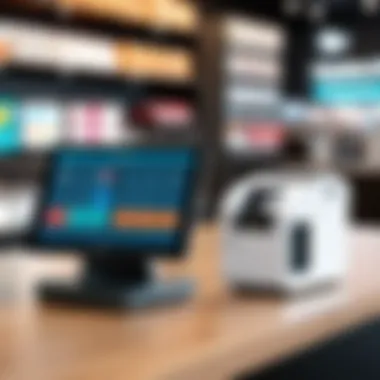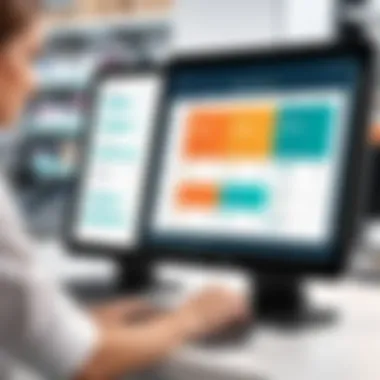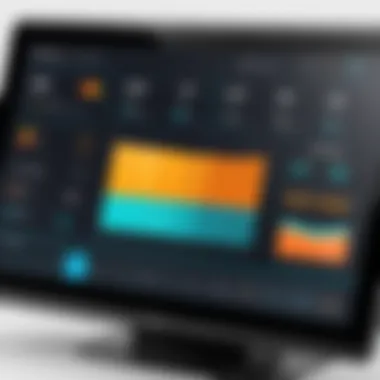Free Retail POS Software: Features, Benefits, and Insights


Intro
In today's retail environment, selecting the right Point of Sale (POS) software can greatly affect a business's efficiency and profitability. This is especially true for small to medium enterprises, which often face tight budgets. Free retail POS software offers a viable alternative, providing essential features without the burden of extensive upfront costs. Understanding what these systems offer is crucial for businesses looking to enhance their operations while maintaining a balance between functionality and affordability.
The following sections will delve deeply into the key features that define free retail POS software, illuminating the unique selling propositions that can help businesses streamline their processes. Then we will explore the pricing models, with attention to different tiers available, ensuring a clear picture of the financial implications of adoption. By the end of this overview, decision-makers will have a well-rounded understanding to make informed choices about the software that best fits their operational needs.
Foreword to Retail POS Software
Retail POS software is a critical component in modern retail operations. Its role goes beyond merely processing transactions; it serves as the nerve center of daily business functions. Understanding this software's definition and its importance helps clarify its influence on operational efficiency and customer experience.
Definition of Retail POS Software
Retail Point of Sale (POS) software refers to a comprehensive system that facilitates the management of retail operations. This includes hardware and software components that collect, store, and manage sales data. Retail POS software typically encompasses functions such as transaction processing, inventory management, sales reporting, and customer relationship management. Usually, it integrates with various types of hardware like barcode scanners, cash drawers, and receipt printers. The term POS signifies not merely the point of sale; it represents the point of management.
Importance in Retail Operations
The significance of retail POS software cannot be overstated. It streamlines operations by automating routine tasks such as inventory tracking and sales reporting. With a functioning POS system, employees can process transactions quickly and efficiently, enhancing the customer experience.
Here are some critical reasons why retail POS software matters:
- Improved Inventory Management: Real-time tracking of inventory helps prevent stockouts and overstocks, ensuring a balanced supply chain.
- Enhanced Customer Experience: With quicker transaction processing, customers experience less wait time, influencing their shopping satisfaction positively.
- Data-Driven Decisions: Retail POS systems provide valuable analytics, empowering decision-makers with insights into sales trends, customer preferences, and more.
- Compliance and Record-Keeping: Accurate records of sales transactions aid in financial reporting and legal compliance.
In summary, retail POS software forms the backbone of retail operations. Understanding its definitions and functionalities allows businesses to realize its potential benefits fully. This article will discuss various free retail POS software options, helping decision-makers choose wisely.
Understanding Free Retail POS Software
Free retail Point of Sale (POS) software is an essential topic for business owners and IT professionals alike. Understanding this segment of retail technology allows decision-makers to optimize their operations without incurring significant costs. Many small to medium-sized enterprises, particularly those with limited budgets, can greatly benefit from the availability of free software solutions, which can be as powerful as their paid counterparts in certain contexts.
What Constitutes Free Software?
Defining what qualifies as free software is crucial for understanding its implications in retail environments. Free software typically means no upfront costs for basic versions. However, businesses should be aware that some software may come with hidden limitations, such as:
- Limited features: Basic versions may lack key functionalities that could enhance sales or inventory tracking.
- User limits: Some free solutions restrict the number of users or devices that can access the software.
- Upgrade paths: Certain free POS systems may push users towards paid upgrades, often leaving them in a dilemma about the long-term costs.
To fully grasp the value of free POS solutions, businesses must evaluate the trade-offs involved. Knowing what to expect from free offerings helps in making better decisions.
Common Features of Free POS Solutions
Not all free retail POS software is created equal. However, some common features tend to be included across various platforms. These features often cater to a wide range of retail needs, such as:
- Basic sales functionalities: Most free POS systems can process transactions, including sales tax calculations.
- Inventory management: Keeping track of stock levels and generating alerts for low inventory.
- Reporting capabilities: Providing essential sales metrics to aid in performance reviews.
While these features are fairly standard, some free systems also offer additional capabilities that could prove beneficial, including:
- Customer relationship management: Managing customer loyalty and tracking buyer behaviors.
- Integration with online sales: Connecting with eCommerce platforms to streamline both in-store and online operations.
In essence, understanding the common features of free POS software allows retailers to leverage its benefits effectively while avoiding pitfalls of choosing inadequate solutions.
Evaluating Free Retail POS Software Options
Evaluating free retail POS software options is crucial for businesses aimed at optimizing their operations without incurring high costs. As retail environments become more tech-driven, understanding what a free POS solution can offer becomes essential. The right selection can streamline transactions, improve inventory management, and enhance customer satisfaction.


Key Factors to Consider
User Interface and Experience
The user interface (UI) of a POS system greatly impacts its effectiveness. A well-designed UI leads to a positive user experience (UX), making it easier for staff to engage with the software. In high-pressure retail situations, an intuitive interface can reduce training time and limit operational errors.
Key characteristics of UI and UX include simplicity, clarity, and responsiveness. When staff can quickly learn and navigate the system, it saves time and increases productivity. One unique feature of many free POS systems is touch-screen compatibility, allowing employees to operate the system with ease. However, some free versions may lack advanced UI adjustments that paid systems offer, potentially limiting usability for specific retail contexts.
Integration Capabilities
Integration capabilities are vital for ensuring that the free POS software works seamlessly with other business tools. A system that integrates with inventory management, accounting software, and eCommerce platforms can create a more cohesive operational flow. This integration can reduce manual data entry, minimizing errors and enhancing efficiency.
A key aspect of integration is the type of APIs offered. Many free POS solutions are designed to play well with popular applications, which can be a huge plus. However, limited integration options may lead some businesses to miss out on features available in paid systems. This is a necessary consideration for businesses looking to scale their operations.
Support and Community
Support and community play a significant role in the successful use of any POS system. Free software may lack official customer support channels, making community forums and user-generated content essential resources. A strong community can provide answers to common queries and share experiences that help others optimize their use of the software.
The key characteristic of community support is accessibility. Many users turn to forums like Reddit to connect with other retailers using the same system to troubleshoot problems or discover new features. However, the challenge lies in the variability of provided support, which can differ sharply from paid solutions that often offer dedicated support teams.
Limitations of Free Solutions
Feature Restrictions
Feature restrictions in free POS solutions can be significant. While they often cover basic transaction processing and sales reporting, advanced features like loyalty programs, advanced analytics, and employee management may remain locked behind paywalls. This could limit a business's ability to leverage its data for growth and improved customer retention.
It is crucial for decision-makers to weigh the benefits of the features offered against their specific business needs. Sometimes, the basics may suffice, allowing a business to function effectively. However, as the business grows, these restrictions could necessitate a switch to a paid solution, which may involve additional costs and complications.
Scalability Issues
Scalability issues are often a concern with free software. A system that works well for a small store may struggle as sales volume increases or additional locations open. Many free systems do not scale up to support increased transaction loads or additional users seamlessly. This limitation can lead to performance bottlenecks that affect daily operations.
Business owners should consider their future growth plans when evaluating these solutions. Choosing software that can evolve with the business may save time and resources in the long run. A weak scalability foundation can create challenges, like disruptions during peak sales seasons.
Security Concerns
Security concerns are paramount when using any cash-handling system. Free POS software may not always provide the level of security as its paid counterparts. Features like data encryption, access controls, and regular security updates are often lacking or inferior in free options.
Businesses should assess the potential risk of data breaches against the costs associated with premium solutions. One unique feature of some advanced POS systems is real-time transaction monitoring, allowing businesses to immediately detect and respond to potential security threats. Without this, free systems pose a higher vulnerability, which can have dire consequences for customer trust and business reputation.
In summary, while evaluating free retail POS software options, understanding user interface, integration capabilities, support availability, and potential limitations becomes essential for making informed decisions.
By focusing on these key aspects, business owners can better navigate the myriad of choices available, ultimately finding a solution that aligns with their operational needs.
Comparative Analysis with Paid Retail POS Software
Analyzing free retail Point of Sale (POS) software in comparison to their paid counterparts reveals critical insights for businesses. Understanding these differences allows stakeholders to make informed decisions that align with their specific needs. While free software offers many alluring features, it often lacks certain capabilities that paid systems provide. This analysis serves to delineate these distinctions clearly.
Cost-Benefit Analysis
The cost-benefit analysis examines the economic implications of selecting either free or paid POS systems. Free POS software presents an attractive upfront option, eliminating initial financial outlays. However, when assessing total costs, the hidden expenses may surface. These might include potential upgrade fees, lack of customer support, or the necessity of supplementary hardware. Paid solutions, while requiring a budget commitment, usually come with quality guarantees, advanced features, and dedicated support that can enhance business operations.


Feature Comparison
In the realm of feature sets, a substantial gulf exists between free and paid POS systems. Below, we delve into specific aspects that demonstrate how these systems differ in functionality.
Customization Options
Customization is a vital factor in selecting a POS system. Free solutions often offer a limited array of templates to suit various businesses. In contrast, paid options present extensive customization capabilities. This flexibility allows businesses to tailor systems according to their brand identity and operational demands.
Each system's adaptability can significantly influence user experience and operational efficiency.
Nevertheless, excessive customization in paid systems may lead to higher costs or complexities in management, which is a consideration for potential users.
Advanced Analytics
Advanced analytics capabilities stand as a key differentiator. Many free systems provide basic sales tracking, but this may not suffice for businesses aiming for data-driven strategies. Paid systems typically include robust analytical tools that enable deeper insights into sales trends, inventory management, and customer behavior.
These insights can influence strategic decisions and optimize performance. However, businesses must weigh the value of such capabilities against their budget and specific needs for analytics.
Customer Relationship Management
Customer relationship management (CRM) features play a pivotal role in fostering customer loyalty and retention. Free retail POS software often lacks sophisticated CRM tools, limiting its effectiveness in managing customer interactions.
Paid variants, however, integrate CRM functionalities, facilitating contact management, targeted marketing campaigns, and customer feedback systems.
This integration may result in substantial long-term benefits, yet businesses should consider whether these features justify the ongoing costs associated with paid systems.
Understanding the comparative landscape can help retailers prioritize their technology investments effectively in alignment with their goals.
Case Studies: Real-World Applications of Free Retail POS Software
The exploration of free retail POS software is incomplete without examining real-world applications. Case studies provide valuable insights into how various businesses integrate free solutions into their operations. They highlight practical benefits, showcase successful implementations, and reveal critical considerations that decision-makers should keep in mind. By reviewing these case studies, businesses can better understand the effectiveness, versatility, and limitations of free retail POS software in different sectors.
Small Retail Businesses
Small retail businesses often face unique challenges, including budget constraints and the need for ease of use. Free retail POS solutions offer an attractive alternative to expensive systems without compromising functionality.
For instance, a local clothing boutique may choose to implement a free POS system like Square. This platform allows the owner to manage sales, track inventory, and generate reports without incurring upfront costs. Businesses like this can leverage tools such as customer management and sales tracking, which are essential for maintaining competitiveness in a saturated market.
Benefits:
- Cost Savings: Many small businesses do not have the luxury of large budgets. Free software eliminates costly subscriptions.
- Ease of Use: User-friendly interfaces help staff adopt the software quickly, minimizing training time.
- Scalability: Small businesses often grow unexpectedly, and free solutions can be upgraded if more features become necessary.
However, small businesses should be cautious of limitations inherent in free versions. Often, they come with reduced functionalities or customer support. Knowing these limitations can help businesses plan better.
Food and Beverage Industry
The food and beverage industry operates on tight margins and requires robust solutions that handle multiple aspects of the business. Free POS systems can fill this need, providing essential features without draining resources.
A prime example lies with a small cafes. By using a free POS solution like Loyverse, the café owner benefits from real-time inventory tracking, sales analytics, and customer loyalty tools. This software allows them to streamline their operations while still focusing on customer experiences, which is vital in food service.
Key Points to Note:
- Time Management: Efficient POS systems reduce transaction time, improving customer satisfaction.
- Inventory Control: Accurate inventory management helps prevent stockouts and surpluses, enhancing profit margins.
- Customer Engagement: Loyalty programs embedded into the system encourage repeat visits, a crucial factor for success in the industry.
To summarize, free retail POS software provides varied, real-world applications across industries. Focusing on case studies shows that, despite limitations, these solutions often bring substantial value, especially for small and mid-sized businesses. Insights gained from these case studies lay the groundwork for informed decision-making in future software selections.
User Experiences and Testimonials
User experiences and testimonials play a vital role in understanding the effectiveness and functionality of free retail POS software. They provide real-world insights that go beyond the theoretical advantages of the systems. These firsthand accounts help prospective users to gauge how the software performs in practice, thus informing their decision-making processes.
By evaluating various user experiences, businesses can identify common themes. Positive testimonials showcase how retail POS systems have improved operational efficiency, streamlined sales processes, and enhanced customer satisfaction. Conversely, accounts of challenges faced can reveal crucial limitations, helping users to set realistic expectations about what the software can offer.


Positive Experiences
Many users express satisfaction with free retail POS software, emphasizing usability and cost-effectiveness.
Most reports highlight the ease of setup and intuitive interfaces. Features such as inventory management, sales tracking, and customer profiles are often mentioned as being user-friendly. The adaptability of these solutions allows small businesses to operate efficiently without the financial burden of premium systems.
In some cases, businesses have reported a significant increase in revenue after implementing a free POS solution. By streamlining transactions and improving inventory accuracy, these programs can boost overall productivity. This is crucial for retailers who are looking to optimize their operations without significant investment.
Challenges Faced
Despite positive experiences, users also encountered hurdles while using free retail POS software. One common issue is limited functionality compared to paid versions. Users often find that essential features, such as advanced reporting tools or customer relationship management functions, are either absent or substantially limited.
Additionally, some users report frustrations regarding support options. While community forums may provide assistance, responses can be inconsistent. This lack of direct customer support poses a challenge when questions or issues arise during critical business hours.
Another frequent challenge is scalability. As businesses grow, they often outpace the capabilities of free solutions. Transitioning to a more robust paid POS system can be complicated, leading to potential data migration concerns.
In summary, user experiences and testimonials provide a nuanced perspective on free retail POS software. While they often highlight significant benefits in efficiency and cost, they also underscore the limitations, guiding businesses to make thoughtful decisions.
Future Trends in Retail POS Software
As businesses adapt to changing consumer behavior and technological advancements, the landscape of retail Point of Sale (POS) software is undergoing significant transformation. This section explores future trends in retail POS software, which are crucial for businesses aiming to stay competitive. By understanding these trends, companies can leverage tools that enhance their operational capabilities and customer experiences.
Emerging Technologies
Mobile POS Solutions
Mobile POS solutions have become increasingly relevant in the retail sector. They allow transactions to be processed on portable devices, such as tablets and smartphones. This mobility is a key characteristic of mobile POS systems, enabling retailers to conduct sales anywhere within their store or even outside their physical locations.
One unique advantage of mobile POS is its ability to reduce checkout times and enhance customer service. Sales associates can assist customers directly on the sales floor rather than directing them to a fixed checkout station. However, a consideration for businesses is the dependency on reliable Wi-Fi connections and the potential security risks associated with mobile transactions.
Cloud Integration
Cloud integration in POS systems represents another vital trend. By storing data on the cloud, retailers can access real-time information from any location without the constraints of traditional hardware. This integration allows for more streamlined operations and enhanced data analysis, crucial for inventory management and customer insights.
A notable feature of cloud-integrated POS systems is their scalability. Businesses can easily add new features or expand their operations without significant hardware investments. However, concerns regarding data privacy and internet outages remain. Retailers must weigh the benefits of cloud integration against these security considerations.
The Role of Artificial Intelligence
Artificial intelligence (AI) is poised to revolutionize retail POS systems further. AI can analyze vast amounts of data quickly, providing retailers with actionable insights for inventory management, customer service, and sales strategies. Predictive analytics powered by AI can improve demand forecasting, enhancing operational efficiency.
In addition to analytics, AI can automate routine tasks within the POS system, such as updating inventory levels or managing customer records. This automation helps businesses focus on strategic planning and customer engagement. As retailers increasingly adopt AI, understanding its role in POS software will become essential for future success.
Ending
The conclusion in this analysis serves multiple crucial functions. It not only summarizes the key points discussed but also contextualizes the information in a way that allows readers to digest it effectively. As businesses increasingly seek cost-effective solutions, understanding the value and limitations of free retail POS software becomes paramount. Decisions made in selecting these software solutions can significantly impact operational efficiency and profitability.
Summary of Key Insights
Throughout this article, we have explored various aspects of free retail POS software. Key insights include:
- Defining Free POS Software: A clear distinction between genuinely free software and those with hidden costs ensures decision-makers know what to expect.
- Common Features: Features such as sales tracking, inventory management, and basic reporting were identified as standard offerings in many free POS systems. Understanding these can guide businesses to choose the most suitable options.
- Evaluative Factors: The discussion on user interface, integration capabilities, and community support highlights essential elements to consider when evaluating software solutions.
- Comparison with Paid Software: Insights into cost-benefit analysis and feature comparisons illustrate that while free options can be viable, they may lack critical features essential for growth, such as advanced analytics and customer relationship management.
- Case Studies: Examining real-world applications enriched our understanding of practical uses and provided encouragement for small businesses considering a change.
- Future Trends: Emerging technologies, especially mobile and cloud solutions, suggest an evolving landscape where free POS software can continue to thrive.
Final Recommendations
- Test Several Options: Before committing, it is advisable to test a few different software systems. Many offer free trials or demos.
- Assess Future Needs: Consider not just current needs but also future scalability. Will the chosen software accommodate growth?
- Engage with User Communities: Participate in forums or groups where current users share experiences. Sites like Reddit can provide firsthand insights.
- Prioritize Security: Ensure any POS solution adheres to industry standards for data protection. Security concerns should not be overlooked, as sensitive customer information is involved.
- Stay Informed: Keeping abreast of trends in POS technology can provide businesses with an edge in choosing the right software that evolves with market demands.
In summary, free retail POS software offers opportunities and challenges. Well-informed decisions can pave the way for significant improvements in retail operations.















